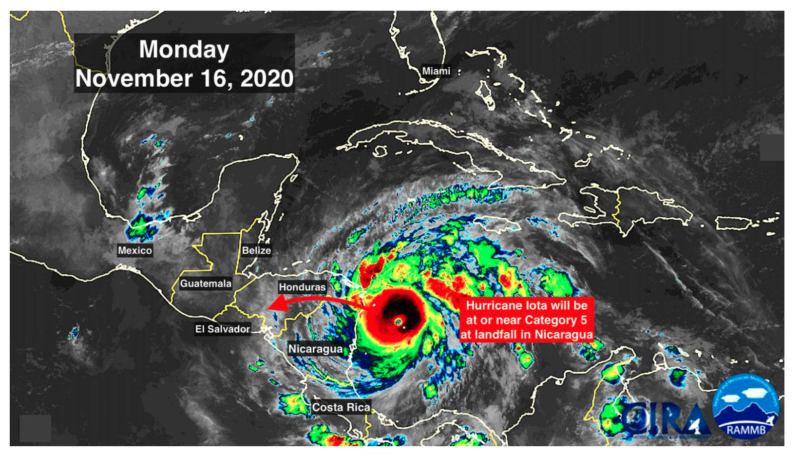3 Lessons from Cat 5 Hurricane Iota

Hurricane Iota November 16, 2020
Hurricane Iota is about to hit Central America, expected to be an extreme category 5 centering on Nicaragua and Honduras. It breaks records as the 13th hurricane in the Atlantic this year and the 30th named storm. Two weeks earlier, Hurricane Eta hit the same region as a Cat 4. It is extremely unusual to get such powerful late-season storms – and now to have two in close succession. Though extreme weather disasters are not new, there are ominous signals here. The last cat 5 hurricane in November was in 1932. We need to get used to the breaking of norms, records, and boundaries.
At the simplest level, the engine for hurricanes is ocean heat. Globally, average ocean temperature is about one degree Celsius, almost two degrees Fahrenheit warmer than a century ago. It has long been forecast that increasing ocean heat will spawn more hurricanes. Shallow seas like the Caribbean can be several times the global average warming. This was exactly what was predicted a half century ago, when the first concern about global warming was raised by NASA’s Dr. James Hansen and others.
At the very least, we must use these record setting disasters as lessons for the future. What can we learn? At the most fundamental are these three takeaways.
- We must slow and ultimately stop the warming as the highest priority. That requires reducing the carbon dioxide (CO2) level in the atmosphere which traps excess heat in the Earth system. Fortunately there is growing support in the U.S. and globally to get off fossil fuels ASAP, with many setting strong targets of “net zero” emissions by 2050. This is often described as being more sustainable. That’s a good step in the right direction and cannot happen too soon. Until we do that, the ocean heat level will increase, likely causing more severe storms.
- Given the pattern of increasing storms, we need to build with the expectation of more severe weather – not just storms, but record-setting heat, rain, and drought.This may mean better materials, engineering, higher elevation above water level, or farther inland. All of these improve resiliency, the resistance to damage and the capacity to recover after an event.
- After some six thousand years of relatively stable sea level, we must begin adaptation for the new era with base sea level is much higher than in all human civilization. Rising sea level is no longer stoppable this century, given that the ice sheets on Greenland and Antarctica are melting faster in a warming world. Though the present annual global rise is still fractions of an inch, the rate is accelerating and the effects are cumulative. Fortunately we likely have a few decades before higher sea level will be really severe, which I usually characterize as a foot (~30 cm) above present levels. Now is the time to begin the planning, engineering, and construction, since buildings and infrastructure typically are in use for 50 – 100 years, and even longer.
For this week, let’s hope and pray for those in Iota’s path.
